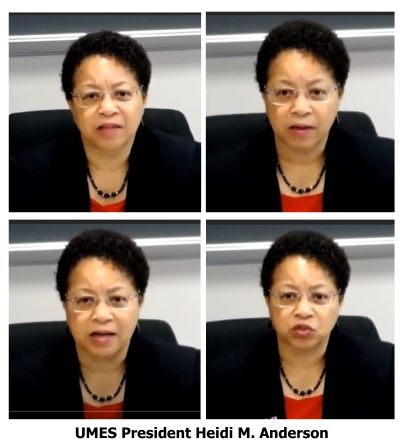1890 land-grant institutions seek long-term federal financial help
Friday, June 18, 2021

UMES President Heidi M. Anderson testified before a Congressional committee this week, voicing support for the federal government to make long-term investments in historically black, land-grant institutions.
Anderson was joined by peers from institutions that emerged in the 19th century to provide formal education in agriculture and related fields to freed Blacks. Leaders of those schools, known collectively as “1890 institutions,” drew attention to poor building conditions, the absence of reliable internet service in rural areas and a need for financial aid as an incentive to make farming an attractive career choice.
“It cannot be overemphasized that the 1890 universities, like UMES, have a pivotal role that we have to uphold,” Anderson said in her opening statement to the U.S. House Agriculture Committee.
The panel, chaired by Rep. David Scott, D-Ga., asked for input on shaping a Congressional strategy that would address daunting financial needs that go back generations.
Scott is credited with successfully advocating three years ago to provide $80 million in short-term scholarship funding for college students who want to pursue a degree in a broad spectrum of agricultural fields.
Anderson, testifying virtually from campus, told the committee that investment has helped UMES boost student enrollment in its agriculture studies and urged Congress to continue that support.
She and her colleagues urged the committee to recommend that Congress commit to creating a permanent scholarship fund.
Anderson also made a case for federal help to modernize land-grant campuses with aging buildings that house agriculture programs.

UMES has 80 buildings, the president said, with an average age of 44 years, and some $90 million in deferred maintenance.
Trigg Hall, home of UMES’ agriculture programming on the historic Academic Oval, was built in 1954 and has antiquated electric service, a poorly functioning climate control system and unreliable wireless internet service.
“Doing something (as) simple as changing the windows becomes very, very problematic because of the historic nature of the building,” she said.
UMES’ George Washington Carver science building is 50 years old and operates with poor ventilation and circulation, a critical function for a building that houses biology and chemistry labs.
“That’s just astounding,” Rep. Kim Schier, (D-Wash.), said. “These are the buildings where we’re doing scientific research, and they are this old and this decrepit.”
Rep. Glenn Thompson, (R-Pa.), used his time to get a measure of challenges land-grant schools and rural communities face with availability of broadband service.
“As we look toward a post-pandemic economy, any conversation about education must also include the issue of connectivity,” Thompson said in prepared remarks. “This is an issue I am working on extensively to move the needle and close this gap, especially for our rural communities.”
The college presidents told Thompson that internet service is spotty or non-existent.
“Many of our local farmers don’t have any connection whatsoever,” Anderson said, “So, it make a big difference as far as lack of interconnectivity. It’s a huge issue here in our area, and we really hope and really encourage Congress to really try to pay attention and help us out in this regard.”
Anderson used the hearing to explain the work UMES is doing to help its surrounding community.
“We’re doing research in things like pest management to try to help (farmers) understand how to increase their knowledge in this particular area (and) how to minimize the pests that are impacting the food that they’re … growing,” Anderson said.
“We’re looking at climate change … and trying to make sure we look at what is happening in this particular area and leveraging technology,” she said, adding “all of us work together in a unified way and help impact those particular issues.”
Rep. Jimmy Panetta, D-California, expressed optimism Congress will allocate $40 billion for agriculture research, including $11.5 billion for research facilities.
“It’s that type of level of funding, which is critical, if we want to provide socially disadvantaged and beginning farmers and producers, along with established producers and farmers, … the tools and knowledge they need to be successful in the 21st century,” Panetta said.
The world’s population is growing, Anderson noted, and “we have to take care of … food needs. We have to have research infrastructure to help us deal with climate needs going forward. So the answer is yes, yes. The more (federal funding), the better.”
Rep. Alma Adams, (D-N.C.), the committee’s vice chair, said, “It’s a priority of mine to make sure that these institutions continue to have resources to unlock the potential of millions of students across the country.”
UMES’ historically black land-grant peers include:
- Alabama A&M University, Normal, Ala.
- Tuskegee University, Tuskegee, Ala.
- University of Arkansas at Pine Bluff, Pine Bluff, Ark.
- Delaware State University, Dover, Del.
- Florida A&M University, Tallahassee, Fla.
- Fort Valley State University, Fort Valley, Ga.
- Kentucky State University, Frankfort, Ky.
- Southern University and A & M College, Baton Rouge, La.
- Lincoln University of Missouri, Jefferson City, Mo.
- Alcorn State University, Lorman, Miss.
- N.C. Agricultural & Technical State University, Greensboro, N.C.
- Central State University, Wilberforce, Ohio
- Langston University, Langston, Okla.
- South Carolina State University, Orangeburg, S.C.
- Tennessee State University, Nashville, Tenn.
- Prairie View A&M University, Prairie View, Texas
- Virginia State University, Chesterfield County, Va.
- West Virginia State University, Institute, W.Va.

